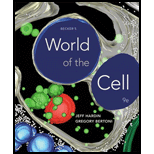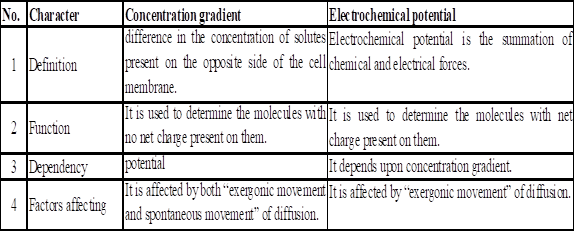
Concept explainers
What is the difference between the concentration gradient and the
To explain: The difference between the concentration gradient and the electrochemical potential.
Introduction: Cell is the basic “fundamental unit” of life. Every organism is composed of a cell. Cells perform cellular activities to maintain their normal functioning. One such important cellular activity is transportation. The process of carrying molecules, gases, organic substances and ions from one part to another part of the cell is termed as transportation. Concentration gradient and the electrochemical potential are two important factors affecting the transportation of solutes across the cell membrane.
Explanation of Solution
The difference between the concentration gradient and the electrochemical potential are as follow:

To explain: The mechanism out of the three types of transport mechanisms which are relevant to the magnitude of the concentration gradient.
Introduction: The process of carrying molecules, gases, organic substances and ions from one part to another part of the cell is termed as transportation. Concentration gradient and the electrochemical potential are two important factors affecting transportation of solutes across the cell membrane. The concentration gradient is used to determine the molecules with no net charge present on them
Explanation of Solution
There are three mechanisms for transportation. These are: Simple Diffusion, Facilitated Diffusion, and Active Transport
The mechanism out of the three types of transport mechanisms that is relevant to the magnitude of the concentration gradient is simple diffusion. This is because only simple diffusion is the transportation method that does not carry any ion. Whereas, both facilitated diffusion and active transport mechanisms transport ions. The concentration gradient is used to determine the molecules with no net charge present on them.
Therefore, the mechanism which is relevant to the magnitude of the concentration gradient is simple diffusion.
To explain: The mechanism out of the three types of transport mechanisms which is important to the electrochemical gradient.
Introduction: The process of carrying molecules, gases, organic substances and ions from one part to another part of the cell is termed as transportation. Concentration gradient and the electrochemical potential are two important factors affecting transportation of solutes across the cell membrane. The concentration gradient is used to determine the molecules with no net charge present on them
Explanation of Solution
There are three mechanisms for transportation. These are simple diffusion, facilitated diffusion, and active transport.
Active transport is a method of transportation in which the solute is transported against a concentration gradient that is from a region of lower concentration to higher concentration. This type of movement requires extra energy as it is performed against a concentration gradient. The mechanism out of the three types of transport mechanisms that is important to the electrochemical gradient is active transport. This is because it is the only mechanism that has a direct relation with the electrochemical gradient. An electrochemical gradient is an important factor for the cause of indirect active transport.
Therefore, active transport is the mechanism that is important to the electrochemical gradient. The reason is that the electrochemical gradient can cause indirect active transport.
Want to see more full solutions like this?
Chapter 8 Solutions
Becker's World of the Cell (9th Edition)
- Name the three classes of membrane transport proteins. Explain which one or ones of these classes is able to move glucose and which can move bicarbonate (HCO3 −) against an electrochemical gradient. In the case of bicarbonate, but not glucose, the ΔG of the transport process has two terms.What are these two terms, and why does the second not apply to glucose? Why are cotransporters often referred to as examples of secondary active transport?arrow_forwardGlucose transport across cell membranes varies depending upon blood glucose levels. When glucose levels are high, glucose transport is accomplished via membrane transporters. When glucose concentrations are low, the transport of glucose across the membrane is dependent upon the sodium ion concentration. What types of transport is observed for glucose? A)simple diffusion at high [glucose], secondary active transport at low [glucose] B)facilitated diffusion at high [glucose], secondary active transport at low [glucose] C)simple diffusion at high [glucose], primary active transport at low [glucose] D)facilitated diffusion at high [glucose], primary active transport at low [glucose]arrow_forwardA red blood cell with an intracellular fluid (ICF) concentration of 280 mmol/L, is placed into an environment were the concentration of the extracellular fluid (ECF) is 305 mmol/L. As a result, water will move across the cell/plasma membrane. a) Name the process by which water moves b) Describe the overall direction of movement of the water. Answer choices: (i) From outside the cell to inside the cell (ii) From inside the cell to outside the cell, or (iii) Equally, into and out of the cell iii Explain your reasoning for your answer to part (c). 1In your answer you must describe the environment on both sides of the membrane, and use 3 of the following 4 terms correctly; hypertonic, hypotonic, lower solute concentration, higher solute concentrationn (2pts -Correct use of biological terminology, and correct spelling is essential. Edit View Insert Format Tools Table 12pt v Paragraph BIUA ...arrow_forward
- the maximal rate of solute movement during diffusion is greater than during mediated transport true or false?arrow_forwardDistinguish between simple diffusion (SD), facilitated diffusion (FD), and active transport (AT) across a membrane for the following questions. (a) Which processes are energy dependent? (b) Which processes need some kind of carrier protein(s)? (c) Which processes can be saturated by substrate? (d) Which processes can establish a concentration gradient? (e) How much energy does it take to transport an uncharged substrate in, if its starting inside concentration is 10-fold greater than outside?arrow_forwardWhat is the primary difference between passive and active transport in terms of concentration gradients?arrow_forward
- What is the application of electrical application in Cell Membrane potential gradient?arrow_forwardFor this practice problem, would the answer be c)NaCl? My reasoning behind this is because molecules under 100 Da can use simple diffusion, while nonpolar molecules and larger molecules like benzene can use channels via facilitated diffusion. However, NaCl dissociates into ions and cannot readily use diffusion?arrow_forwardWhen the kidneys filter plasma, the filtered glucose is reabsorbed from the renal tubules and is not passed in the urine. However, glucose can appear in the urine when the blood sugar is exceptionally high. Given that glucose is reabsorbed by carrier-mediated transport, what functional aspect of carrier-mediated transport does the appearance of glucose in urine demonstrate? Explain.arrow_forward
- Which of the following statements about the sodium-potassium pump is correct? A) Both sodium and potassium move down their concentration gradient across the membrane B) 2 sodium ions are pumped out of the cell against their concentration gradient C) The sodium-potassium pump is a type of cotransport. D) ATP is used as an energy sourcearrow_forwardwhat are the two types of facilitated diffusion and what is an example of each?arrow_forwardA) Consider membrane filtration. What is concentration polarization and why does it occur? B) What are the important parameters that affect the diffusivity in/across membranes and what do The they mean physically? C) Consider the Krogh Cylinder model. What is the physical meaning of the critical radiusand why does it occur?arrow_forward
 Human Physiology: From Cells to Systems (MindTap ...BiologyISBN:9781285866932Author:Lauralee SherwoodPublisher:Cengage Learning
Human Physiology: From Cells to Systems (MindTap ...BiologyISBN:9781285866932Author:Lauralee SherwoodPublisher:Cengage Learning
